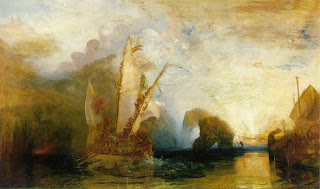I've always admired the art of Joseph Mallord William Turner (1775-1851), so it was only natural that I had my artist-heroine, Marcia Brownlow, admire him too. I recently guest posted a brief excerpt from The Flower to the Painter on Rachael De Vienne's blog. The three paragraphs describe Marcia's impressions upon first viewing three great Turners at London's National Gallery.
The year is 1877, a time of transition in the art world, with the Impressionists gaining recognition in Paris, while London looks more to the works of the Academic Neo-Classicists, the Romantic Neo-Gothicists, the Pre-Raphaelites and their newer offshoot, The Aesthetic Movement. Marcia is torn between the old and the new. She ponders the present and future of art as she contemplates the work of one of the greatest painters of the recent past. Her reflections are accompanied by pictures of three Turner masterpieces.
http://wardancingpixie.blogspot.com/



